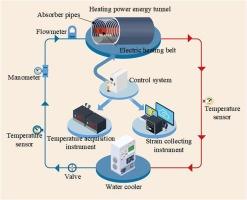热电能隧道管片衬砌传热性能及热应力试验研究
IF 7.4
1区 工程技术
Q1 CONSTRUCTION & BUILDING TECHNOLOGY
引用次数: 0
摘要
能量隧道是利用放置的吸收管在隧道外或隧道内收集热量的隧道。加热动力能量隧道收集安装在加热动力隧道中的加热管道发出的热量。在抽热过程中,隧道空气温度的变化会影响隧道的换热性能,产生隧道衬砌的热应力。本文在北京采用盾构驱动法构建了相似比为1:5的加热动力能量隧道,并在不同的隧道初始空气温度、入口流体温度和流体速度下进行了间歇运行模式下的实验。结果表明:随着隧道初始空气温度的升高,提取的热流密度(q)呈上升趋势;当初始空气温度从40℃变化到60℃时,运行120 min后热流密度q增加33.3%。管片衬砌的热应力(σt)随隧道初始温度的升高呈对数增长。q和σt均与吸收管入口流体温度呈负线性关系。Q和σt也随吸收管内流体速度的增加而呈对数增长。灵敏度分析表明,在三个运行参数中,隧道初始空气温度的变化对q和σt的影响最大。结果还表明,在现有试验条件下,热电能隧道管片衬砌在达到最大热流密度的同时是安全的。研究结果对内热源能隧道的能量利用系统设计和隧道衬砌设计具有重要的指导意义。本文章由计算机程序翻译,如有差异,请以英文原文为准。

Experimental investigation on heat transfer performance and thermal stress of segment lining in a heating power energy tunnel
Energy tunnel is a tunnel that uses the positioned absorber pipes to collect heat outside or inside the tunnel. Heating power energy tunnel collects the heat emitted by the heating pipelines installed in the heating power tunnel. During the heat extraction process, the variation of tunnel air temperature may affect the heat transfer performance and bring about thermal stress of the tunnel lining. In this paper, a heating power energy tunnel with the similarity ratio of 1:5 is constructed using the shield-driven method in Beijing, and experiments are performed under different initial air temperatures in the tunnel, fluid temperatures at the inlet and fluid velocities in an intermittent operation mode. The results show that the heat flux extracted (q) ascends with increasing the tunnel initial air temperature. when the initial air temperature changed from 40 to 60 °C, the heat flux q increases by 33.3 % after 120 min operation. The thermal stress of the segment lining (σt) exhibits logarithmic growth with the increment of tunnel initial air temperature. Both q and σt show a negatively linear relationship with the inlet fluid temperature of the absorber pipe. q and σt also increase logarithmically with fluid velocity in the absorber pipe. Sensitivity analysis indicates that, among the three operation parameters, the variation of tunnel initial air temperature has the highest impact on q and σt. The results also indicate that the segment lining of the heating power energy tunnel is in safety while achieving the maximum heat flux under present test conditions. These findings are of great significance in guiding the design of energy utilization systems and tunnel linings for internal heat source energy tunnels.
求助全文
通过发布文献求助,成功后即可免费获取论文全文。
去求助
来源期刊

Tunnelling and Underground Space Technology
工程技术-工程:土木
CiteScore
11.90
自引率
18.80%
发文量
454
审稿时长
10.8 months
期刊介绍:
Tunnelling and Underground Space Technology is an international journal which publishes authoritative articles encompassing the development of innovative uses of underground space and the results of high quality research into improved, more cost-effective techniques for the planning, geo-investigation, design, construction, operation and maintenance of underground and earth-sheltered structures. The journal provides an effective vehicle for the improved worldwide exchange of information on developments in underground technology - and the experience gained from its use - and is strongly committed to publishing papers on the interdisciplinary aspects of creating, planning, and regulating underground space.
 求助内容:
求助内容: 应助结果提醒方式:
应助结果提醒方式:


